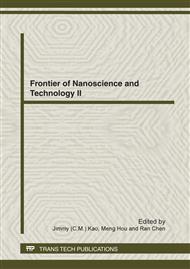p.18
p.23
p.27
p.31
p.35
p.39
p.43
p.50
p.54
Preparation and Characterization of Cellulose Nanowhiskers in N, N-Dimethylacetamide
Abstract:
Reinforcement of polymer with plant whiskers is a way of improving mechanical properties. Cellulose nanowhiskers (CNW) were separated from commercially available wood pulpboard. Different microscopy techniques, thermal gravimetric analysis, X-ray diffraction were used to study the structure and properties of the microcrystalline cellulose (MCC) and CNW. Because of the high specific surface area of CNW, the increases in total amorphous character of the cellulose decrease the relative degree of crystallinity. After chemical and physical treatment, the CNW in the length of several μm and diameters ranging from 20 - 50 nm was obtained. Both the initial decomposing temperature and temperature of maximum decomposing rate of CNW is higher than MCC, but lower than wood pulpboard.
Info:
Periodical:
Pages:
35-38
Citation:
Online since:
June 2012
Authors:
Price:
Сopyright:
© 2012 Trans Tech Publications Ltd. All Rights Reserved
Share:
Citation:


